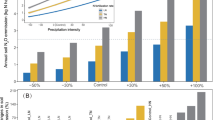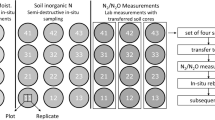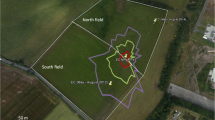Abstract
To better understand the effects of increased N input and dry periods on soil nitrous oxide (N2O) emission, we examined a unique data-set of weather, soil microclimate, N input, and N2O emissions (using the eddy covariance method), measured at a fertilized grassland over the period 2003–2008. We found that the N2O emission (11.5 kg N ha−1 year−1), the ratio of N2O emission to N input (3.4), and the duration of elevated N2O flux (57 days) in 2003 were about two times greater than those of the following years. 2003 had the highest annual N input (343 kg N ha−1 year−1) which exceeded the agronomical requirements for Irish grasslands (up to 306 kg ha−1 year−1). In the summer of 2003, the site had a significantly higher soil temperature, lower WFPS and lowest rainfall of all years. Large N2O emission events followed rainfall after a long dry period in the summer of 2003, attributed to dominant nitrification processes. Furthermore, in the non summer periods, when temperature was lower and WFPS was higher and when there were prior N applications, lower N2O emissions occurred and were attributed to dominant denitrification processes. Throughout the study period, the N input and soil dryness related factors (duration of WFPS under 50%, summer average WFPS, and low rainfall) showed exponential relationships with N2O emission and the ratio of N2O emission to N input. Based on these findings, we infer that the observed anomalously high N2O emission in 2003 may have been caused by the combined effects of excess N input above the plant uptake rate, elevated soil temperature, and N2O flux bursts that followed the rewetting of dry soil after an unusually long dry summer period. These results suggest that high N input above plant uptake rate and extended dry periods may cause abnormal increases in N2O emissions.




Similar content being viewed by others
References
Anon (2006) European Communities (Good Agricultural Practice for Protection of Waters) Regulations 2006. S.I. No. 378 of 2006. Department of Environment, Heritage and Local Government. The Stationary Office, Dublin
Appel T (1998) Non-biomass soil organic N—the substrate for N mineralization flushes following soil drying-rewetting and for organic N rendered CaCl2-extractable upon soil drying. Soil Biol Biochem 30:1445–1456. doi:10.1016/S0038-0717(97)00230-7
Barton L, Kiese R, Gatter D, Butterbach-Bahl K, Buck R, Hinz C, Murphy D (2008) Nitrous oxide emissions from a cropped soil in a semi-arid climate. Glob Change Biol 14:177–192
Bouwman AF (1996) Direct emission of nitrous oxide from agricultural soils. Nutr Cycl Agroecosyst 46:53–70. doi:10.1007/BF00210224
Bouwman AF, Boumans LJM, Batjes NH (2002) Emissions of N2O and NO from fertilized fields: summary of available measurement data. Global Biogeochem Cycles 16:1058. doi:10.1029/2001GB001811
Ciais Ph, Reichstein M, Viovy N, Granier A, Ogee J, Allard V, Aubinet M, Buchmann N, Bernhofer C, Carrara A, Chevallier F, De Noblet N, Friend AD, Friedlingstein P, Grunwald T, Heinesch B, Keronen P, Knohl A, Krinner G, Loustau D, Manca G, Matteucci G, Miglietta F, Ourcival JM, Papale D, Pilegaard K, Rambal S, Seufert G, Soussana JF, Sanz MJ, Schulze ED, Vesala T, Valentini R (2005) Europe-wide reduction in primary productivity caused by the heat and drought in 2003. Nature 437:529–533. doi:10.1038/nature03972
Coulter BS, Lalor S (2008) Major and micro nutrient advice for productive agricultural crops. Teagasc, Johnstown Castle, Co Wexford
Crutzen PJ (1970) The influence of nitrogen oxides on the atmospheric ozone content. Quart J Roy Meteor Soc 96:320–325
Davidson EA, Firestone MK (1988) Measurement of nitrous oxide dissolved in soil solution. Soil Sci Soc Am J 52:1201–1203
Davidson EA, Matson PA, Vitousek PM, Riley R, Dunkin K, Garciamendez G, Maass JM (1993) Processes regulating soil emissions of NO and N2O in a seasonally dry tropical forest. Ecol 74:130–139
Davidson EA, Nepstad DC, Ishida FY, Brando PM (2008) Effects of an experimental drought and recovery on soil emissions of carbon dioxide, methane, nitrous oxide, and nitric oxide in a moist tropical forest. Glob Change Biol 14:2582–2590. doi:10.1111/j.1365-2486.2008.01694.x
Denef K, Six J, Bossuyt H, Frey SD, Elliott ET, Merckx R, Paustian K (2001) Influence of dry-wet cycles on the interrelationship between aggregate, particulate organic matter, and microbial community dynamics. Soil Biol Biochem 33:1599–1611. doi:10.1016/S0038-0717(01)00076-1
Di HJ, Cameron KC (2008) Sources of nitrous oxide from 15N-labelled animal urine and urea fertiliser with and without a nitrification inhibitor, dicyandiamide (DCD). Aust J Soil Res 46:76–82. doi:10.1071/SR07093
Dobbie KE, McTaggart IP, Smith KA (1999) Nitrous oxide emissions from intensive agricultural systems: variations between crops and seasons, key driving variables, and mean emission factors. J Geophys Res 104:26891–26899. doi:10.1029/1999jd900378
Donoso L, Santana R, Sanhueza E (1993) Seasonal variation of N2O fluxes at a tropical savannah site- soil consumption of N2O during the dry season. Geophys Res Lett 20:1379–1382. doi:10.1029/93GL01537
Dunne S, Hanafin J, Lynch P, McGrath R, Nishimura E, Nolan P, Ratnam JV, Semmler T, Sweeney C, Varghese S, Wang S (2008) Ireland in a warmer world, scientific predictions of the Irish climate in the twenty-first century. Community Climate Change Consortium for Ireland (C4I), p 109. Available at http//www.c4i.ie/docs/IrelandinaWarmerWorld.pdf (Last Accessed, 18-01-2010)
Flechard CR, Neftel A, Jocher M, Ammann C, Fuhrer J (2005) Bi-directional soil/atmosphere N2O exchange over two mown grassland systems with contrasting management practices. Glob Change Biol 11:2114–2127. doi:10.1111/j.1365-2486.2005.01056.x
Flechard CR, Ambus P, Skiba U, Rees RM, Hensen A, van Amstel A, n Dasselaar AV, Soussana J-F, Jones M, Clifton-Brown J, Raschi A, Horvath L, Neftel A, Jocher M, Ammann C, Leifeld J, Fuhrer J, Calanca P, Thalman E, Pilegaard K, Di Marco C, Campbell C, Nemitz E, Hargreaves KJ, Levy PE, Ball BC, Jones SK, van de Bulk WCM, Groot T, Blom M, Domingues R, Kasper G, Allard V, Ceschia E, Cellier P, Laville P, Henault C, Bizouard F, Abdalla M, Williams M, Baronti S, Berretti F, Grosz B (2007) Effects of climate and management intensity on nitrous oxide emissions in grassland systems across Europe. Agric Ecosyst Environ 121:135–152. doi:10.1016/j.agee.2006.12.024
Flessa H, Beese F (1995) Effects of sugarbeet residues on soil redox potential and nitrous oxide emission. Soil Sci Soc Am J 59:1044–1051
Flessa H, Ruser R, Schilling R, Loftfield N, Munch JC, Kaiser EA, Beese F (2002) N2O and CH4 fluxes in potato fields: automated measurement, management effects and temporal variation. Geoderma 105:307–325. doi:10.1016/S0016-7061(01)00110-0
Foken T, Wichura B (1996) Tools for quality assessment of surface-based flux measurements. Agric For Meteorol 78:83–105. doi:10.1016/0168-1923(95)02248-1
Forster P, Ramaswamy V, Artaxo P, Berntsen T, Betts R, Fahey DW, Haywood J, Lean J, Lowe DC, Myhre G, Nganga J, Prinn R, Raga G, Schulz M, Van Dorland R (2007) Changes in atmospheric constituents and in radiative forcing. In: Solomon S, Qin D, Manning M, Chen Z, Marquis M, Averyt KB, Tignor M, Miller HL (eds) Climate Change 2007: The physical science basis. Contribution of working group I to the fourth assessment report of the intergovernmental panel on climate change. Cambridge University Press, Cambridge
Gaskell JF, Blackmer AM, Bremner JM (1981) Comparison of effects of nitrate, nitrite, and nitric oxide on reduction of nitrous oxide to dinitrogen by soil microorganisms. Soil Sci Soc Am J 45:1124–1127
Goldberg SD, Gebauer G (2009) Drought turns a Central European Norway spruce forest soil from an N2O source to a transient N2O sink. Glob Change Biol 15:850–860. doi:10.1111/j.1365-2486.2008.01752.x
Grant RF, Pattey E (2008) Temperature sensitivity of N2O emissions from fertilized agricultural soils: mathematical modeling in ecosys. Global Biogeochem Cycles 22:GB4019. doi:10.1029/2008GB003273
Grant RF, Pattey E, Goddard TW, Kryzanowski LM, Puurveen H (2006) Modeling the effects of fertilizer application rate on nitrous oxide emissions. Soil Sci Soc Am J 70:235–248. doi:10.2136/sssaj2005.0104
Halvorson AD, Del Grosso SJ, Reule CA (2008) Nitrogen, tillage, and crop rotation effects on nitrous oxide emissions from irrigated cropping systems. J Environ Qual 37:1337–1344. doi:10.2134/jeq2007.0268
Horváth L, Führer E, Lajtha K (2006) Nitric oxide and nitrous oxide emission from Hungarian forest soils; linked with atmospheric N-deposition. Atmos Environ 40:7786–7795. doi: 10.1016/j.atmosenv.2006.07.029
Hsieh CI, Leahy P, Kiely G, Li CS (2005) The effect of future climate perturbations on N2O emissions from a fertilized humid grassland. Nutr Cycl Agroecosyst 73:15–23. doi:10.1007/s10705-005-7129-4
Hyde B, Hawkins M, Fanning A, Noonan D, Ryan M, O’Toole P, Carton O (2006) Nitrous oxide emissions from a fertilized and grazed grassland in the South East of Ireland. Nutr Cycl Agroecosyst 75:187–200. doi:10.1007/s10705-006-9026-x
Intergovernmental Panel on Climate Change (2006) 2006 IPCC guidelines for national greenhouse gas inventories. Available via http://www.ipcc-nggip.iges.or.jp/public/2006gl/index.html. Cited 1 September 2009
Jaksic V, Kiely G, Albertson J, Oren R, Katul G, Leahy P, Byrne K (2006) Net ecosystem exchange of grassland in contrasting wet and dry years. Agric For Meteorol 139:323–334
Jones SK, Rees RM, Skiba UM, Ball BC (2007) Influence of organic and mineral N fertiliser on N2O fluxes from a temperate grassland. Agric Ecosyst Environ 121:74–83. doi:10.1016/j.agee.2006.12.006
Kessavalou A, Doran JW, Mosier AR, Drijber RA (1998) Greenhouse gas fluxes following tillage and wetting in a wheat-fallow cropping system. J Environ Qual 27:1105–1116
Kieft TL, Soroker E, Firestone MK (1987) Microbial biomass response to a rapid increase in water potential when dry soil is wetted. Soil Biol Biochem 19:119–126. doi:10.1016/0038-0717(87)90070-8
Kiely G, Xu X, Hsieh C-I, Leahy P, Sottocornola M, Laine A, Mishurov M, Albertson J, Katul G, Oren R, and Carton O (2009) CELTICFLUX: measurement and modelling of GHG fluxes from grasslands and a Peatland in Ireland. AsiaFlux Newsletter No 28, March 2009
Kitzler B, Zechmeister-Boltenstern S, Holtermann C, Skiba U, Butterbach-Bahl K (2006) Controls over N2O, NOx and CO2 fluxes in a calcareous mountain forest soil. Biogeosci 3:383–395
Knowles R (1982) Denitrification. Microbiol Rev 46:43–70
Kowalchuk GA, Stephen JR (2001) Ammonia-oxidizing bacteria: a model for molecular microbial ecology. Annu Rev Microbiol 55:485–529. doi:10.1146/annurev.micro.55.1.48
Kruskal W, Wallis W (1952) Use of ranks in one-criterion variance analysis. J Am Stat Assoc 47:583–621
Kuzyakov Y, Friedel JK, Stahr K (2000) Review of mechanisms and quantification of priming effects. Soil Biol Biochem 32:1485–1498. doi:10.1016/S0038-0717(00)00084-5
Leahy P, Kiely G, Scanlon TM (2004) Managed grasslands: a greenhouse gas sink or source? Geophys Res Lett 31:L20507. doi:10.1029/2004GL021161
Legg JO, Meisinger JJ (1982) Soil nitrogen budgets. In: Stevenson FJ (ed) Nitrogen in agricultural soils. Agron Monogr 22. American Society of Agronomy, Crop Science Society of America, Soil Science Society of America, Madison, pp 503–566
McSwiney CP, Robertson GP (2005) Nonlinear response of N2O flux to incremental fertilizer addition in a continuous maize (Zea mays L.) cropping system. Glob Change Biol 11:1712–1719. doi:10.1111/j.1365-2486.2005.01040.x
Mikha MM, Rice CW, Milliken GA (2005) Carbon and nitrogen mineralization as affected by drying and wetting cycles. Soil Biol Biochem 37:339–347. doi:10.1016/j.soilbio.2004.08.003
Mosier AR, Parton WJ, Hutchinson GL (1983) Modeling nitrous-oxide evolution from cropped and native soils. Ecol Bull 35:229–241
Motulsky HJ, Christopoulos A (2004) Fitting models to biological data using linear and nonlinear regression: a practical guide to curve fitting. Oxford University Press, New York
Nobre AD, Keller M, Crill PM, Harriss RC (2001) Short-term nitrous oxide profile dynamics and emissions response to water, nitrogen and carbon additions in two tropical soils. Biol Fertil Soils 34:363–373. doi:10.1007/s003740100396
Prieme A, Christensen S (2001) Natural perturbations, drying-wetting and freezing-thawing cycles, and the emission of nitrous oxide, carbon dioxide and methane from farmed organic soils. Soil Biol Biochem 33:2083–2091. doi:10.1016/S0038-0717(01)00140-7
Rudaz AO, Davidson EA, Firestone MK (1991) Sources of nitrous oxide production following wetting of dry soil. FEMS Microbiol Lett 85:117–124
Ruser R, Flessa H, Russow R, Schmidt G, Buegger F, Munch JC (2006) Emission of N2O, N2 and CO2 from soil fertilized with nitrate: effect of compaction, soil moisture and rewetting. Soil Biol Biochem 38:263–274. doi:10.1016/j.soilbio.2005.05.005
Saetre P, Stark JM (2005) Microbial dynamics and carbon and nitrogen cycling following re-wetting of soils beneath two semi-arid plant species. Oecologia 142:247–260. doi:10.1007/s00442-004-1718-9
SAS Institute Inc (2009) SAS/STAT® 9.2 User’s Guide, 2nd edn. Cary
Scanlon TM, Kiely G (2003) Ecosystem-scale measurements of nitrous oxide fluxes for intensely grazed, fertilized grassland. Geophys Res Lett 30(16):1852. doi:10.1029/2003GL017454,2003
Scholes MC, Martin R, Scholes RJ, Parsons D, Winstead E (1997) NO and N2O emissions from savanna soils following the first simulated rains of the season. Nutr Cycl Agroecosyst 48:115–122. doi:10.1023/A:1009781420199
Shapiro SS, Wilk MB (1965) An analysis of variance test for normality (complete samples). Biometrika 52:591–611. doi:10.1093/biomet/52.3-4.591
Sheffield J, Wood EF (2008) Global trends and variability in soil moisture and drought characteristics, 1950–2000, from observation-driven Simulations of the terrestrial hydrologic cycle. J Climate 21:432–458. doi:10.1175/2007JCLI1822.1
Sillmann J, Roeckner E (2008) Indices for extreme events in projections of anthropogenic climate change. Clim Change 86:83–104. doi:10.1007/s10584-007-9308-6
Smith K, Thomson P, Clayton H, McTaggart I, Conen F (1998) Effects of temperature, water content and nitrogen fertilisation on emissions of nitrous oxide by soils. Atmos Environ 32:3301–3309. doi:10.1016/S1352-2310(97)00492-5
Smith KA, Ball T, Conen F, Dobbie KE, Massheder J, Rey A (2003) Exchange of greenhouse gases between soil and atmosphere: interactions of soil physical factors and biological processes. Eur J Soil Sci 54:779–791. doi:10.1046/j.1365-2389.2003.00567.x
Teepe R, Brumme R, Beese F (2001) Nitrous oxide emissions from soil during freezing and thawing periods. Soil Biol Biochem 33:1269–1275. doi:10.1016/S0038-0717(01)00084-0
Van Gestel M, Merckx R, Vlassak K (1993) Microbial biomass responses to soil drying and rewetting: the fate of fast- and slow-growing microorganisms in soils from different climates. Soil Biol Biochem 25:109–123. doi:10.1016/0038-0717(93)90249-B
Voronovich V, Kiely G (2007) On the gap in the spectra of surface-layer atmospheric turbulence. Bound Layer Meteor 122:67–83. doi:10.1007/s10546-006-9108-y
Wang W, Yung Y, Lacis A, Mo T, Hansen J (1976) Greenhouse effects due to man-mad perturbations of trace gases. Science 194:685–690
Zaitchik BF, Macalady AK, Bonneau LR, Smith RB (2006) Europe’s 2003 heat wave: a satellite view of impacts and land-atmosphere feedbacks. Int J Climatol 26:743–769. doi:10.1002/Joc.1280
Zebarth BJ, Rochette P, Burton DL (2008) N2O emissions from spring barley production as influenced by fertilizer nitrogen rate. Can J Soil Sci 88:197–205
Acknowledgments
The authors are grateful to Paul Leahy for his valuable comments on earlier versions of the manuscript. We appreciate discussions with László Horváth and Barbara Kitzler. Nelius Foley provided essential instrumental and data collection support for this research. We would like to acknowledge support of the Department of Agriculture of Irish Government under Research Stimulus Fund Programme (RSF 06 372) and Environmental Protection Agency of Ireland under CelticFlux Programme (2001-CC/CD-(5/7)).
Author information
Authors and Affiliations
Corresponding author
Rights and permissions
About this article
Cite this article
Kim, DG., Mishurov, M. & Kiely, G. Effect of increased N use and dry periods on N2O emission from a fertilized grassland. Nutr Cycl Agroecosyst 88, 397–410 (2010). https://doi.org/10.1007/s10705-010-9365-5
Received:
Accepted:
Published:
Issue Date:
DOI: https://doi.org/10.1007/s10705-010-9365-5




